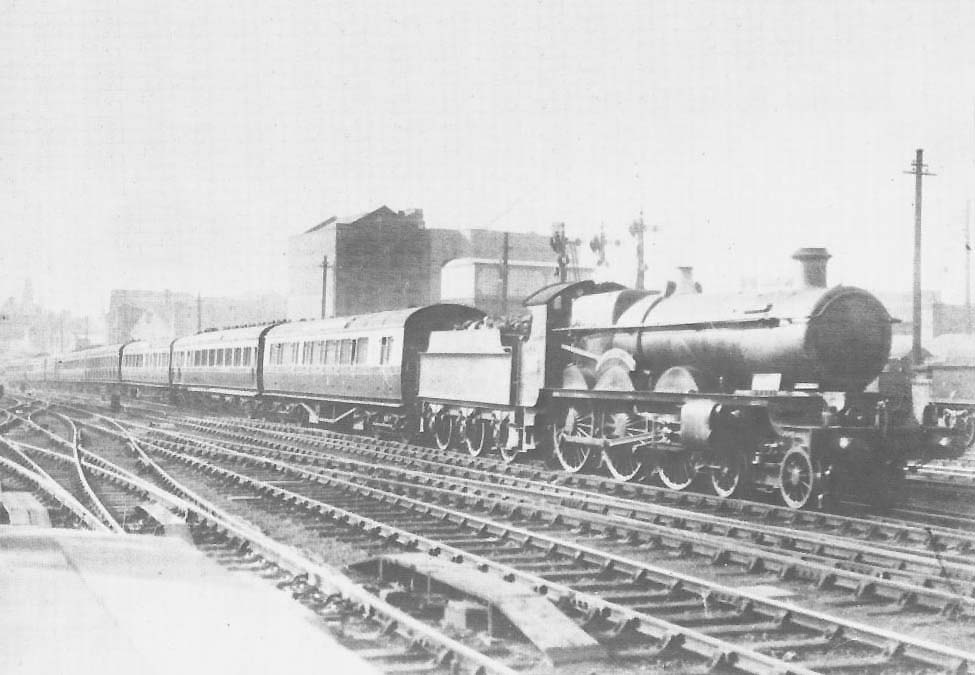 |
|
GWR Route: Banbury to Wolverhampton
GWR Route: North Warwickshire Line
Birmingham Snow Hill Station: gwrbsh1764
 |
Great Western Railway 40xx (Star) class 4-6-0 No 4033 'Queen
Victoria' arriving at the north end of Birmingham Snow Hill with an up express
in 1927. The first coach is a fifty-seven foot long, brake composite, ganged
corridor carriage from Lot 1322 (diagram E113). These were steel panelled stock
built in July 1923 with running numbers 7949 – 7964. A number of these
coaches were fitted with dual braking systems to allow their use on
inter-company passenger services. The passenger accommodation comprised; two
first class compartments and four third class compartments. In addition there
was a lavatory at each end of the compartment corridor and a guard’s
compartment. They were condemned in July 1962. The second coach is a seventy
foot long, ganged, first class diner restaurant car from either Lot 1114, 1115
or 1118 (diagrams H13 and H14). These twelve restaurant cars were all built in
1906 with running numbers 9522 – 9533 (following their renumbering in
1907). The passenger accommodation was forty two first class seats and the
recessed doors lead to them being called 'Concertina Coaches'. These restaurant
cars were refurbished in 1936 with flush steel panelling and downgraded to
third class diners. After the second world war they were rebuilt again with
some being fitted with six wheel bogies to give a smoother ride.
Locomotive No 4033 was built at Swindon Works in November
1910 as part of lot 180 and the ten locomotives in this lot were all given the
names of English Queens. These four cylinder express passenger locomotives were
designed by Chief Mechanical Engineer (CME) George Churchward, who incorporated
the French De Glehn cylinder arrangement as a simple with two sets of valve
gear. As such they were the forerunners of the 'Castle' and 'King' classes and
handled the elite expresses of their day. No 4033 was built with a 14 / 84
superheater arrangement (14 tubes / 84 elements) in a fully coned standard No 1
boiler (type D4), which operating at a pressure of 225 lbs producing a tractive
effort at 85% of 25,090 lb. This classified the locomotives in power group D,
while their maximum axle weight of 18 tons, 12 cwt restricted them to main
lines and a few branch lines (colour code Red). Shortly after construction
top-feed apparatus became standard. This extended boiler life by removing
impurities from the boiler water by spraying the cold feed water into the steam
space over a removable sloped tray. One additional safety feature was the
provision of brakes on all wheels including the bogies, but these bogie brakes
were complicated to maintain and as their application was deemed to provide
little extra braking benefit, they were removed from November 1923. Outside
elbow steam pipes were fitted to No 4033 in April 1940. When built the Star
class locomotives were provided with the new long fendered 3,500 gallon
tenders. In 1934, No 4033 was paired with Churchward pattern 3,500 gallon
tender; No 2224 from lot A111, which was also a long fendered type, built in
1924. This is probably the tender in the photograph. From 1938 the
‘Star’ class locomotives were generally paired with the larger
Collett pattern 4,000 gallon tenders. No 4033 was known to have been allocated
to Paddington (OOC) in May 1922. In January 1934 the locomotive was allocated
to Worcester shed (WOS). In January 1938, No 4033 was allocated to Bath Road
shed (BRD) in Bristol, was there prior to nationalisation in December 1947 and
withdrawn from this shed (82A) in June 1951.
Robert Ferris
 back back

|
